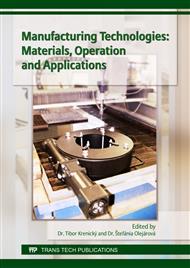[1]
X.B. Chen, A. Geddam, Z.J. Yuan, Accuracy improvement of three-axis CNC machining centers by quasi-static error compensation, J. of Man. Sys. 16 (1997) 323-336.
DOI: 10.1016/s0278-6125(97)88463-4
Google Scholar
[2]
E. Rivin, Stiffness and damping in mechanical design. CRC Press, (1999).
Google Scholar
[3]
M.T. Lin, S.K. Wu, Modeling and improvement of dynamic contour errors for five-axis machine tools under synchronous measuring paths, Int. J. of Mach. T. and Man. 72 (2013) 58-72.
DOI: 10.1016/j.ijmachtools.2013.06.005
Google Scholar
[4]
J. Mayr et al., Comparing different cooling concepts for ball screw systems. Proceedings ASPE Annual Meeting, (2010).
Google Scholar
[5]
P. Baron, M. Kočiško, J. Dobránsky, M. Pollák, M. Telišková, Research and application of methods of technical diagnostics for the verification of the design node, Measurement 94 (2016) 245-253.
DOI: 10.1016/j.measurement.2016.07.089
Google Scholar
[6]
P. Korba, J. Piľa, J. Sabo, M. Antoško, The use of CAX systems as a tool to reduce the economic costs in the aviation industry, in: Proc. of SGEM, Albena, 2014, pp.385-392.
DOI: 10.5593/sgem2014/b21/s7.049
Google Scholar
[7]
X.S. Wang, M. Kang, X.Q. Fu, C.L. Li, Predictive modeling of surface roughness in lenses precision turning using regression and support vector machines, Int. J. Mach. Tool and Manuf., 87 (2016) 5-8.
DOI: 10.1007/s00170-013-5231-3
Google Scholar
[8]
Ľ. Šooš, P. Križan, M. Matúš, J. Beniak, New design of the headstock - generator for creating folded rotary motion. Int. J. of Mech. 9 (2015) 246-251.
Google Scholar
[9]
P. Božek, P. Pokorný, Analysis and evaluation of differences dimensional products of production system. Appl. Mech. and Mater. 611 (2014) 339-345.
DOI: 10.4028/www.scientific.net/amm.611.339
Google Scholar
[10]
P. Huang, W.B. Lee, Cutting force prediction for ultra-precision diamond turning by considering the effect of tool edge radius, Int. J. Mach. Tool and Manuf. 109 (2016) 1-7.
DOI: 10.1016/j.ijmachtools.2016.06.005
Google Scholar
[11]
International Standard ISO 230-2, Machine tools, Test code for machine tools, Part 2: Determination of accuracy and repeatability of positioning of numerically controlled axes.
DOI: 10.3403/30107093
Google Scholar


